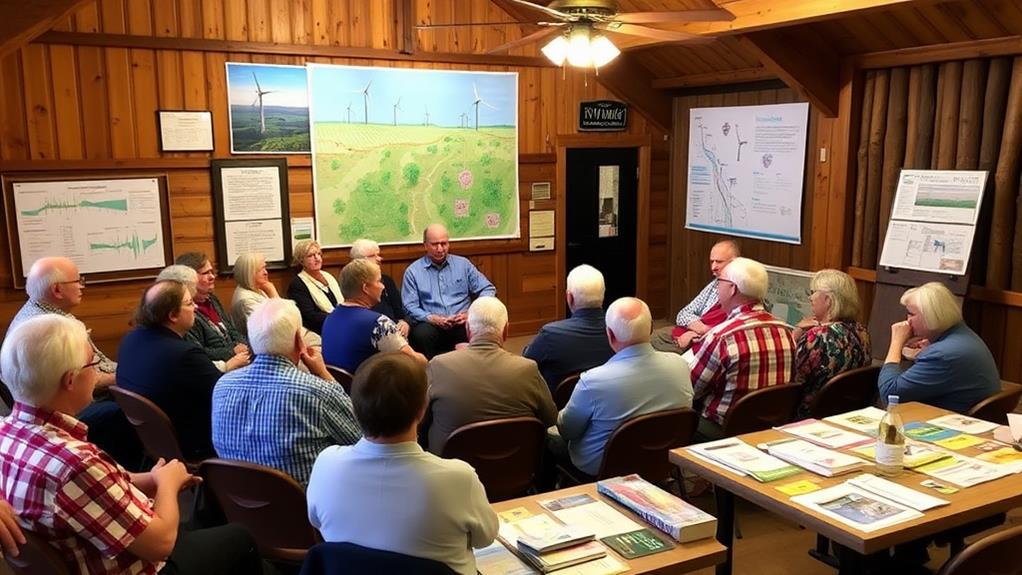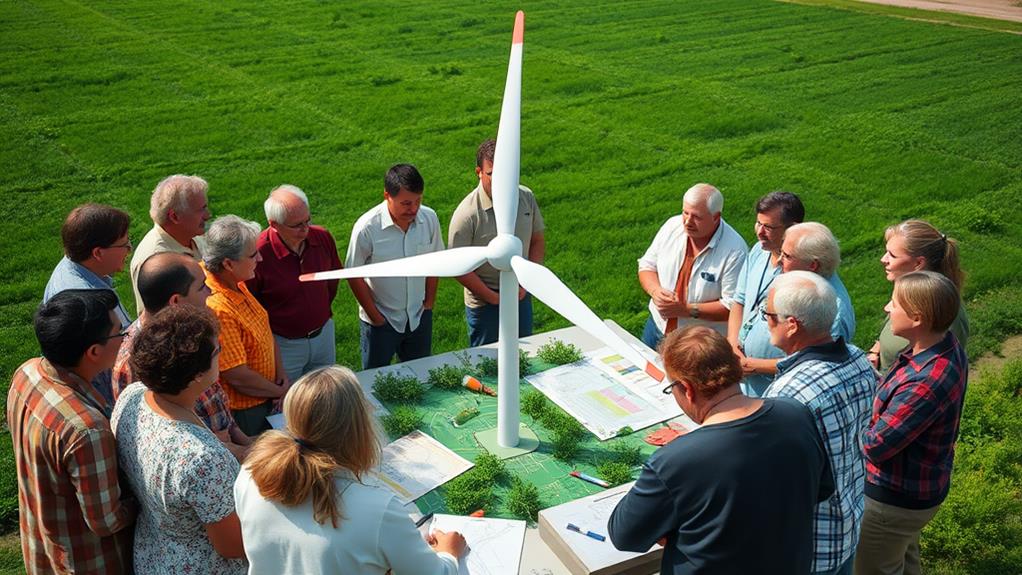To successfully launch community wind energy initiatives, we should follow seven critical steps. First, we engage and assess community interest through surveys and educational workshops, targeting a minimum 60% support level. Second, we develop a thorough project plan that includes feasibility studies and sustainable goals. Third, we secure necessary permits and funding, exploring grants and public consultations. Fourth, we foster community ownership via cooperatives and share schemes. Fifth, we promote local economic development by creating jobs and engaging businesses. Sixth, we implement ongoing communication strategies, ensuring transparency. Finally, we build trust and relationships through open dialogue, which enhances community investment in renewable energy initiatives. More insights await as we explore these steps further.
Key Takeaways
- Engage the community through surveys and workshops to gauge interest and educate residents about wind energy benefits.
- Develop a clear project plan with defined goals, feasibility studies, and a timeline for implementation.
- Secure necessary permits and funding by understanding regulations and exploring financial opportunities, including grants and crowdfunding.
- Foster community ownership by creating local cooperatives and introducing share schemes for residents to invest in projects.
- Maintain ongoing communication through regular updates, community meetings, and educational programs to build trust and address concerns.
Engage Local Stakeholders
Engaging local stakeholders is essential for the success of community wind energy initiatives. By actively involving community members, we can cultivate trust and foster a genuine sense of ownership in renewable energy projects. Establishing transparent communication channels—such as regular meetings and updates—allows us to address concerns and misconceptions, thereby reducing opposition. Involving local organizations and leaders enhances credibility and encourages diverse input on project goals. Furthermore, conducting educational workshops empowers stakeholders with the knowledge necessary for increased participation and investment. Building partnerships with local businesses not only supports the economy, but greatly strengthens stakeholder relationships. Together, these strategies promote robust community engagement, ensuring that our wind energy initiatives thrive and contribute meaningfully to our collective freedom and sustainability goals.
Assess Community Interest

Evaluating community interest in wind energy projects is pivotal for their success. We can assess local enthusiasm through surveys and community meetings, aiming for at least 60% support from respondents. To promote understanding of the benefits of renewable energy, we should organize informational workshops detailing economic advantages, such as job creation—approximately 1.17 jobs per MW installed. Establishing a community advisory group with diverse stakeholders enhances transparency and trust, while sharing success stories like the Pleasant Valley Community Wind Project can inspire local residents.
| Engagement Method | Description |
|---|---|
| Surveys | Gauge support and interest from local residents. |
| Community Meetings | Foster open dialogue and address concerns. |
| Informational Workshops | Educate on benefits and impacts of wind projects. |
| Advisory Group | Promote diverse representation and transparency. |
| Success Stories | Illustrate potential economic impacts and benefits. |
Develop a Project Plan

To guarantee the success of our wind energy initiative, we must start by defining clear project goals that encompass our desired energy output, community benefits, and environmental impacts. Effective project planning requires us to conduct thorough feasibility studies, evaluating wind resources, land availability, and potential economic benefits, guaranteeing we create a solid business case. Early engagement with local communities through community meetings allows us to gather valuable input, address concerns, and foster ownership of the project. We should develop an extensive project timeline outlining key milestones, responsibilities, and resources needed for each stage of the renewable energy development. This meticulous approach will not only enhance our project's viability but also guarantee we're steering towards a sustainable future for all involved.
Secure Permits and Funding

After laying the groundwork with a solid project plan, our next step is to secure the necessary permits and funding for our community wind energy initiative. Securing permits typically involves maneuvering local zoning laws, conducting environmental assessments, and engaging in a public consultation process, which can take several months to years. To enhance our chances, we should establish a robust stakeholder engagement strategy, as community support is crucial for approval rates and funding opportunities. For funding options, we can explore grants that may exceed $100,000, crowdfunding efforts, and partnerships with local businesses. Developing an extensive business plan that outlines our project goals, economic benefits, and sustainability measures will further demonstrate our initiative's potential returns on investment, attracting essential financial support.
Implement Educational Workshops

As we implement educational workshops, our primary objective is to engage community members in understanding the multifaceted benefits of wind energy projects, including job creation and economic growth. By incorporating hands-on demonstrations and interactive sessions, we aim to foster a sense of ownership and participation, which is essential for successful project buy-in. Additionally, involving local experts and reputable organizations will enhance the credibility of these workshops, ensuring that the information shared is both accurate and relevant to our community's needs.
Workshop Objectives and Goals
Implementing educational workshops serves as an essential step in deepening our community's understanding of wind energy and its benefits. Our workshop objectives focus on informing community members about renewable energy systems, emphasizing the role of local wind resources in sustainable development. By incorporating interactive elements, such as demonstrations of wind technology and case studies like the Pleasant Valley Community Wind Project, we aim to illustrate successful community engagement. Additionally, we'll provide data on potential job opportunities arising from construction and maintenance phases, showcasing the tangible advantages of community wind initiatives. Engaging local experts as facilitators guarantees credibility, while regular workshops establish a continuous dialogue, allowing us to adapt to community needs and strengthen support for these initiatives.
Engaging Local Community Members
Engaging local community members through educational workshops is essential for fostering a strong connection to wind energy initiatives. By organizing these workshops, we can help participants understand the numerous benefits of renewable energy, including lower electricity costs and reduced reliance on fossil fuels, thereby cultivating a sense of ownership and empowerment. Utilizing interactive sessions, we can explain the technical aspects of wind energy, such as wind turbine operations and the feasibility studies evaluating local wind resources, ensuring that community members feel informed and involved. Collaborating with local schools and community centers for hands-on demonstrations encourages active participation, while regularly scheduled workshops provide a platform for voicing concerns and sharing feedback, enhancing transparency and trust throughout the project development process.
Foster Community Ownership

To foster community ownership in wind energy initiatives, we should actively encourage local participation by establishing cooperative structures that empower residents to invest in and manage projects. Transparent decision-making processes are essential, as they not only facilitate informed choices but also build trust and strengthen relationships among community members. By engaging in regular communication and providing updates, we can guarantee that everyone feels invested in the success of these renewable energy projects, ultimately enhancing their sustainability and financial viability.
Encourage Local Participation
As we commence our community wind energy initiatives, fostering local ownership is essential for ensuring the project's long-term success. By establishing local cooperatives, we can empower residents to invest in and share profits from the wind energy project, thereby promoting community ownership. Regular community meetings will serve as platforms for education, addressing concerns, and integrating feedback, thereby enhancing trust and investment. We can implement a community share scheme, enabling locals to purchase shares, which not only secures funding but also provides them with a direct financial stake in our sustainable energy venture. In addition, collaborating with local businesses reinforces community ties and supports local economic development, ensuring that the benefits circulate within our community, creating a robust financial model for all involved.
Transparent Decision-Making Processes
Building on our efforts to encourage local participation, implementing transparent decision-making processes will further enhance community ownership in our wind energy initiatives. By empowering community members to actively participate in all stages, we promote a sense of commitment and accountability. Key components of this approach include:
- Regular community meetings and workshops to facilitate open communication.
- Clear governance structures, such as community boards, to reflect diverse interests.
- Educational programs that inform members about the benefits and operations of wind projects.
- Transparent updates on project progress, financials, and impacts to reinforce trust and buy-in.
These initiatives are essential for ensuring the success of renewable energy projects, fostering a cooperative environment where every voice matters.
Build Trust and Relationships
Trust and relationships form the backbone of successful community wind energy initiatives. To build trust, we must establish transparent communication channels that keep community members informed about project developments and decision-making processes, minimizing misinformation. Regular community meetings and workshops foster engagement, allowing residents to voice their concerns and actively participate, enhancing their sense of ownership. Implementing community ownership programs, such as cooperative shares, enables local members to invest in the project and share in its economic returns. Additionally, educational initiatives emphasizing the benefits of wind energy—like job creation and energy independence—can build local support. Finally, integrating feedback mechanisms will guarantee that community interests are represented in project decisions, further solidifying trust and commitment to the initiative.
Establish Ongoing Communication

Effective communication is essential for the success of community wind energy initiatives. To guarantee transparency and trust, we must establish ongoing communication that keeps everyone informed about project development and timelines. Here are four key strategies to foster this engagement:
- Utilize Various Channels: Implement newsletters, dedicated project websites, and social media platforms for regular updates.
- Host Community Meetings: Organize workshops and forums to encourage direct dialogue, address concerns, and promote ownership.
- Encourage Feedback: Create structured mechanisms allowing community members to voice opinions and suggestions, integrating their input into planning.
- Leverage Tools: Use resources like LandGates for effective stakeholder engagement, guaranteeing continuous involvement in renewable energy projects.
Frequently Asked Questions
What Are the Steps in the Wind Energy Project?
When we explore wind energy projects, we engage our community, assess sites, consider funding sources, navigate regulatory requirements, select appropriate technology, and involve stakeholders, ensuring a sustainable approach that empowers our collective freedom and energy independence.
What Are the Steps in the Wind Energy Production Process?
Did you know that community wind projects can reduce energy costs by up to 20%? In our journey, we prioritize site selection, technology evaluation, environmental assessments, community engagement, financing options, and steering regulatory permits for successful wind energy production.
How Do You Introduce Wind Energy?
Introducing wind energy, we'll explore its benefits, engage our community, and discuss policy support. With advancements in technology, diverse funding options, and a positive environmental impact, we can create a sustainable future together. Let's get started!
What Is the First Crucial Step for Developing a Wind Project?
When we think about developing a wind project, the first essential step's got to be site assessment. We'll engage the community, guarantee financial modeling's spot-on, and involve stakeholders for a breezy, compliant journey ahead!










